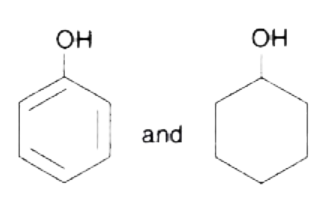Give one chemical test to distinguish between the following pairs of compounds.
Iron (II) chloride solution and Iron (III) chloride solution.
To distinguish between Iron (II) chloride solution (FeCl2) and Iron (III) chloride solution (FeCl3), we can perform a chemical test using sodium hydroxide (NaOH). Here’s a step-by-step solution:
1. Preparation of Solutions: Take two separate test tubes. In one test tube, add a few drops of Iron (II) chloride solution (FeCl2), and in the other test tube, add a few drops of Iron (III) chloride solution (FeCl3).
2. Addition of Sodium Hydroxide: To each test tube, add a few drops of sodium hydroxide (NaOH) solution.
3. Observation of Precipitate:
- In the test tube containing Iron (II) chloride (FeCl2), a dirty green precipitate will form. This precipitate is due to the formation of ferrous hydroxide (Fe(OH)2).
- In the test tube containing Iron (III) chloride (FeCl3), a reddish-brown precipitate will form. This precipitate is due to the formation of ferric hydroxide (Fe(OH)3).
4. Conclusion: By observing the color of the precipitate, you can distinguish between the two solutions:
- A dirty green precipitate indicates the presence of Iron (II) chloride (FeCl2).
- A reddish-brown precipitate indicates the presence of Iron (III) chloride (FeCl3).
Summary of the Chemical Test:
- Test: Addition of NaOH
- FeCl2 (Iron II Chloride): Forms a dirty green precipitate (Fe(OH)2).
- FeCl3 (Iron III Chloride): Forms a reddish-brown precipitate (Fe(OH)3).
- In the test tube containing Iron (II) chloride (FeCl2), a dirty green precipitate will form. This precipitate is due to the formation of ferrous hydroxide (Fe(OH)2).
- In the test tube containing Iron (III) chloride (FeCl3), a reddish-brown precipitate will form. This precipitate is due to the formation of ferric hydroxide (Fe(OH)3).
- A dirty green precipitate indicates the presence of Iron (II) chloride (FeCl2).
- A reddish-brown precipitate indicates the presence of Iron (III) chloride (FeCl3).
- Test: Addition of NaOH
- FeCl2 (Iron II Chloride): Forms a dirty green precipitate (Fe(OH)2).
- FeCl3 (Iron III Chloride): Forms a reddish-brown precipitate (Fe(OH)3).
Topper's Solved these Questions
- ANALYTICAL CHEMISTRY- USE OF AMMONIUM HYDROXIDE AND SODIUM HYDROXIDEBOOK - ICSECHAPTER - ANALYTICAL CHEMISTRY- USE OF AMMONIUM HYDROXIDE AND SODIUM HYDROXIDEEXERCISE - Additional Questions for Practice
51 Videos
- ANALYTICAL CHEMISTRYBOOK - ICSECHAPTER - ANALYTICAL CHEMISTRYEXERCISE - Figure Based Questions
2 Videos
- ANALYTICAL CHEMISTRY-USE OF AMMONIUM & SODIUM HYDROXIDEBOOK - ICSECHAPTER - ANALYTICAL CHEMISTRY-USE OF AMMONIUM & SODIUM HYDROXIDEEXERCISE - Additional Questions
6 Videos
Similar Questions
Give a chemical test to distinguish between the following pairs of compounds:

View SolutionGive one chemical test to distinguish between the following pairs of compounds :
Ethanol and 2 propanol.
View SolutionGive one good chemical test to distinguish between the following pairs of compounds
Urea and acetamide
View SolutionGive one chemical test to distinguish between the following pairs of compounds :
Ethanol and acetic acid
View SolutionGive one chemical test to distinguish between the following pairs of compounds :
Phenol and benzoic acid.
View SolutionGive any chemical test to distinguish between the following pair of compounds : acetine and phenol.
View SolutionGive one test each to distinguish between the following pairs of chemicals :
Iron (III) chloride solution and copper chloride solution.
View SolutionGive chemical tests to distinguish between the following pairs of compounds :
Propanal and propanone.
View SolutionGive one chemical test to distinguish between the following pairs of compounds :
Acetone and benzaldehyde.
View SolutionGive one chemical test each to distinguish between the following pairs of compounds : Propanal and Propanone.
View Solution
